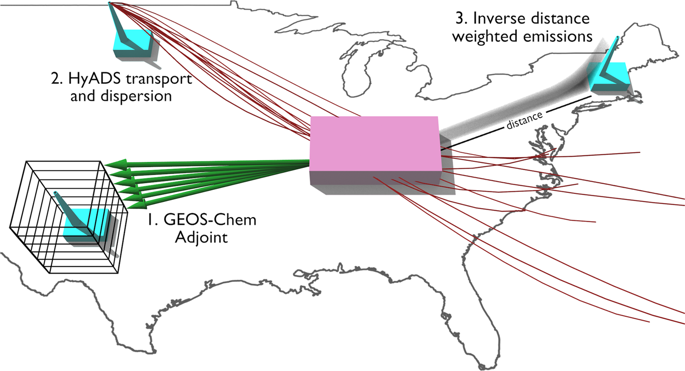Journal of Exposure Science and Environmental Epidemiology ( IF 4.1 ) Pub Date : 2020-03-17 , DOI: 10.1038/s41370-020-0219-1 Lucas R F Henneman 1 , Irene C Dedoussi 2, 3 , Joan A Casey 4, 5 , Christine Choirat 6 , Steven R H Barrett 3 , Corwin M Zigler 7

|
Expanded use of reduced complexity approaches in epidemiology and environmental justice investigations motivates detailed evaluation of these modeling approaches. Chemical transport models (CTMs) remain the most complete representation of atmospheric processes but are limited in applications that require large numbers of runs, such as those that evaluate individual impacts from large numbers of sources. This limitation motivates comparisons between modern CTM-derived techniques and intentionally simpler alternatives. We model population-weighted PM2.5 source impacts from each of greater than 1100 coal power plants operating in the United States in 2006 and 2011 using three approaches: (1) adjoint PM2.5 sensitivities calculated by the GEOS-Chem CTM; (2) a wind field-based Lagrangian model called HyADS; and (3) a simple calculation based on emissions and inverse source-receptor distance. Annual individual power plants’ nationwide population-weighted PM2.5 source impacts calculated by HyADS and the inverse distance approach have normalized mean errors between 20 and 28% and root mean square error ranges between 0.0003 and 0.0005 µg m−3 compared with adjoint sensitivities. Reduced complexity approaches are most similar to the GEOS-Chem adjoint sensitivities nearby and downwind of sources, with degrading performance farther from and upwind of sources particularly when wind fields are not accounted for.
中文翻译:

量化暴露于单个点源空气污染排放的简单和复杂方法的比较。
在流行病学和环境正义调查中广泛使用降低复杂性的方法促使对这些建模方法进行详细评估。化学传输模型 (CTM) 仍然是大气过程的最完整表示,但在需要大量运行的应用中受到限制,例如评估来自大量来源的单个影响的应用。这种限制激发了现代 CTM 派生技术与有意更简单的替代方法之间的比较。我们使用三种方法对 2006 年和 2011 年在美国运营的 1100 多个燃煤电厂的人口加权 PM 2.5源影响进行建模:(1) 伴随 PM 2.5GEOS-Chem CTM 计算的灵敏度;(2) 基于风场的拉格朗日模型,称为 HyADS;(3) 基于排放量和逆源-受体距离的简单计算。与伴随敏感性相比,由 HyADS 和反距离方法计算的年度单个发电厂全国人口加权 PM 2.5源影响的标准化平均误差在 20% 到 28% 之间,均方根误差范围在 0.0003 到 0.0005 µg m -3之间。降低复杂性的方法与源附近和下风向的 GEOS-Chem 伴随敏感性最相似,尤其是在不考虑风场的情况下,远离源和上风的性能会降低。











































 京公网安备 11010802027423号
京公网安备 11010802027423号